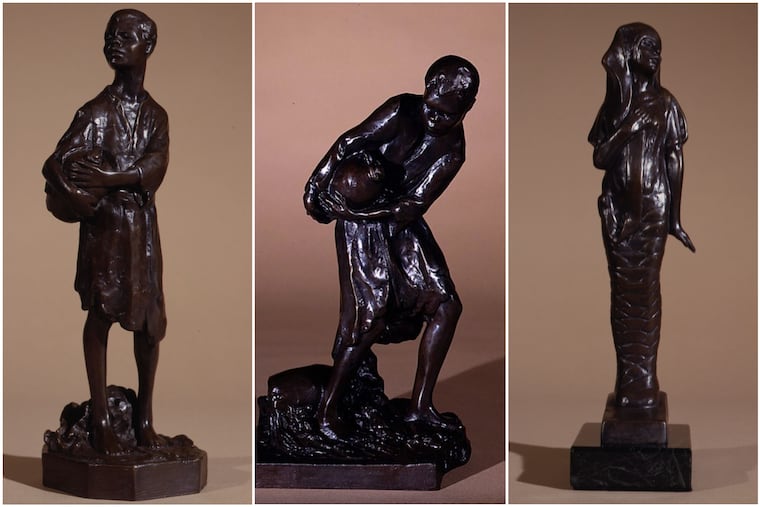Overlooked Philly artist Meta Vaux Warrick Fuller’s sculptures come to The Philadelphia Show
A friend of W.E.B. Du Bois, Fuller was born and raised in the city. Her work will be on sale among rare maps, American visual art, and antique furniture, at the Philadelphia Museum of Art

Though she ran in the same circles as W.E.B. Du Bois, Alain Locke, and Auguste Rodin, artist Meta Vaux Warrick Fuller never received the same recognition as her peers. Called the “sculptor of horrors,” she created figural works that reflected the suffering and violence African Americans experienced in the early 1900s.
“Up until the end, she was always, I think, saddened by the fact that she didn’t get her proper due,” said Eric Hanks, who runs M. Hanks Gallery in Fullerton, Calif., and will show some of Fuller’s sculptures in The Philadelphia Show that opens in the Philadelphia Museum of Art’s East Terrace this weekend. “She was discriminated against in her day as a person of African descent, and … because she was a female … And despite all that, she still was able to create some powerful works that deserve everybody’s attention.”
Born and raised in Philadelphia, Fuller studied at University of the Arts (then known as the Pennsylvania Museum and School of Industrial Art). Her parents, a barbershop owner and a beautician, were well-regarded leaders in the city’s Black community. In 1899, she went to Paris, where she met the renowned intellectual Du Bois and the famous sculptor Rodin, who both became big fans of her work.
Upon returning to the United States, she married a psychiatrist and moved to Framingham, Mass. Though her husband preferred that she focus on domestic work instead of art, she secretly built a studio nearby where she continued her craft. Sadly, her existing body of work is limited, made even smaller after a 1910 fire destroyed a Philadelphia warehouse that housed many of the sculptures she had made in France.
She sculpted Black Americans in pain and in defiance, in labor and in victory, crafting stark and dignified portraits that were unparalleled, especially during her era. Her sculpture Emancipation stands in Boston’s Harriet Tubman Park, her ode to abolition. Her words on the inscription read: “Humanity weeping over her suddenly freed children who beneath the gnarled fingers of Fate, step forth into the world, unafraid.”
After the vicious lynching of pregnant Mary Turner, Fuller sculpted In Memory of Mary Turner As A Silent Protest Against Mob Violence, which depicted Turner holding her baby away from the bloodthirsty mob with flames at her feet.
Du Bois commissioned Ethiopia Awakening, one of her most notable pieces, created sometime between 1915-1921. The work is widely considered a precursor to the Harlem Renaissance, incorporating the aesthetics from Egypt and other African cultures to underscore the liberation of Black Americans. Mummy wrappings encase the legs of a woman who looks like a butterfly shedding a cocoon, emerging from the constraints to seek new beginnings. Various iterations of the sculpture exist today, including a 5-foot-tall bronze that stands in New York’s Schomburg Center for Research in Black Culture.
“The image itself just symbolizes this awakening consciousness of the story of great African civilization … [showing] that, even before slavery, there were these great civilizations that were led by and created by persons of color,” said Hanks.
At the annual art and antiques fair that runs April 28-30, Hanks’ gallery, which specializes in African American art, joins 41 exhibitors selling rare maps, American visual art, antique furniture, and other collectibles. He is selling a small Ethiopia Awakening sculpture from a limited edition of seven bronzes, along with two artist’s proofs, for $50,000. The two other Fuller sculptures for sale are from 1930: Waterboy (Bending) and Waterboy (Standing), which are priced at $40,000 each.
Hanks acquired the works from Fuller’s granddaughter, Meta Fuller Waller, who was named for the sculptor. “Part of the granddaughter’s wishes was to help get her grandmother’s recognition that she never felt that she had gotten,” said Hanks. When he first received them, the pieces were only plaster and clay, so he worked with Waller to put them in bronze. Waller’s death in the 9/11 attacks on the Pentagon put an untimely stop to their collaborative efforts. Some proceeds from the sale will go to Fuller’s family.
Though under-recognized in the canon of American art history, Fuller has received new appreciation in recent years as art historians have revisited her legacy. The greatest collection of her work is held at the Danforth Art Museum in Framingham, including a recreation of her studio and some 340 artworks and objects. In Philadelphia, a historical marker dedicated to her stands at 254 S. 12th Street, where she lived — not far from the Pennsylvania Academy of the Fine Arts, where she once exhibited.
The Philadelphia Show runs April 28-30 on the East Terrace of the Philadelphia Museum of Art, 2600 Benjamin Franklin Pkwy, thephiladelphiashow.com.